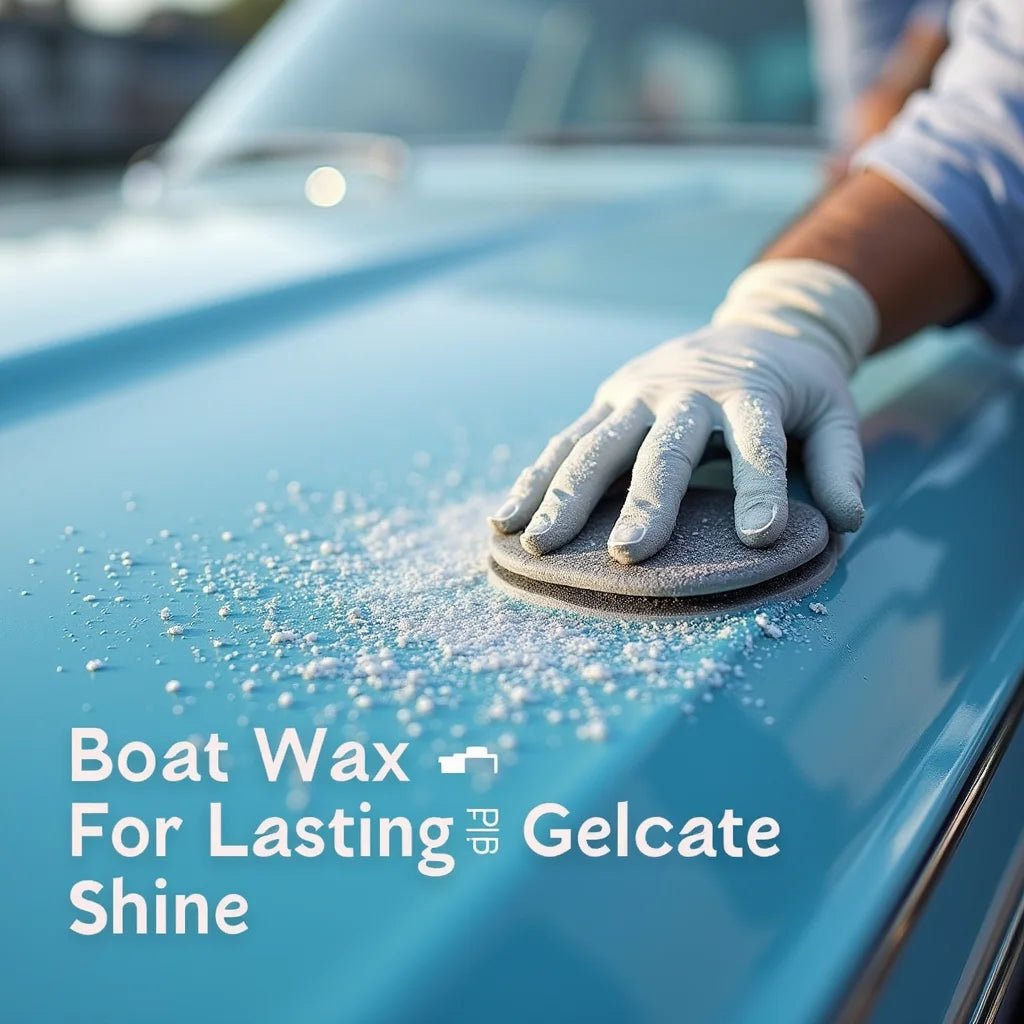Updated on: 2025-10-12
- Myths vs. Facts about Boat Wax and Polish
- Step-by-Step Guide: How to Wax and Polish a Boat to Remove Oxidation
- Step 1: Inspect and Prepare
- Step 2: Wash and Decontaminate
- Step 3: Use a Hull Oxidation Remover
- Step 4: Polish the Gelcoat
- Step 5: Seal with Marine Wax and Polish
- Step 6: Cure, Buff, and Maintain
- Step 7: Tips for Saltwater Use
- Frequently Asked Questions on Boat Wax and Polish
- What is the best boat wax and polish for saltwater use?
- How often should I wax and polish my boat?
- What is the difference between marine wax and polish?
- Summary & Key Takeaways on Boat Wax and Polish
If your gelcoat looks dull or chalky, a careful routine with boat wax and polish can help restore a smooth, bright surface and protect it from sun, water, and grime. Many boaters wonder whether to use marine wax and polish together, how to handle oxidation, and what works best for fiberglass hulls. This guide shares a gentle, step-by-step approach to gelcoat restoration, including when a hull oxidation remover may be appropriate. You will also find a simple schedule to keep the finish looking glossy. If you prefer to explore related care topics, you are welcome to visit the Blog for more resources.
Myths vs. Facts about Boat Wax and Polish
Myth 1: One product does it all
It may feel convenient to rely on a single bottle, yet boat polish and wax serve different roles. Polish refines the surface by removing light oxidation and swirls, while wax or sealant protects the finish. Using both thoughtfully can help achieve a deeper shine and longer-lasting protection.
Myth 2: Wax removes oxidation
Wax does not correct damage; it covers and protects. Light oxidation typically responds better to a gentle polish. For heavier oxidation, a dedicated hull oxidation remover or compound is more suitable before sealing the surface with wax.
Myth 3: More pressure creates more shine
Excess force can create haze or even burn the gelcoat. Slow passes, clean pads, and moderate pressure usually deliver a more even finish. A measured approach is both kinder to the surface and more predictable.
Myth 4: Waxing once a year is enough for all boats
Frequency depends on sun exposure, water type, storage, and use. Boats that live outdoors or run in saltwater may appreciate more frequent care. A light maintenance coat during the season can help extend the life of the protective layer.
Myth 5: A high gloss always means strong protection
Shine shows smoothness, not durability. Some polishes brighten without leaving a robust barrier. A balanced routine includes surface correction and a final protective coat from a marine wax and polish or sealant designed for gelcoat.
Myth 6: Only new gelcoat can look new
Thoughtful gelcoat restoration can bring back depth and clarity. Careful washing, selective use of a hull oxidation remover, and proper sealing can improve the look of even an older fiberglass hull.
Step-by-Step Guide: How to Wax and Polish a Boat to Remove Oxidation
Step 1: Inspect and Prepare
Start with a slow walkaround in good light. Note chalky spots, stains, dock rash, and any areas with heavy oxidation or scratches. Gather your supplies: boat-safe wash, microfiber mitts, clay mitt or decontamination towel, masking tape, polish, marine wax or sealant, pads, and a dual-action polisher if you prefer.
Step 2: Wash and Decontaminate
Rinse thoroughly to remove loose grit. Use a gentle, pH-balanced boat wash and a microfiber mitt. After drying, consider a clay mitt or decontamination towel to lift embedded contaminants. This smoother surface helps the polish work evenly and reduces the chance of marring.
Step 3: Use a Hull Oxidation Remover
For chalky or faded areas, a hull oxidation remover or a light compound can be helpful. Work on small sections. Use minimal pressure and keep the pad clean. Wipe residue and check your progress in indirect light. If the surface looks clearer and color is returning, you are preparing well for polishing.
Step 4: Polish the Gelcoat
Polish refines the surface by smoothing micro-scratches and haze. A dual-action polisher with a light- to medium-cut pad can make results more consistent, though hand application works for small areas. Move in overlapping passes and keep the tool flat. Wipe off residue as you go, and inspect for an even gloss. This step supports gelcoat restoration by improving clarity before protection.
Step 5: Seal with Marine Wax and Polish
Apply a thin, even coat of marine wax and polish or a marine-grade sealant. Thin coats cure more predictably and are easier to buff. Some boaters prefer a synthetic sealant for longevity and then a finishing wax for warmth and gloss. If you are looking for the best boat wax and polish for fiberglass hulls, consider products labeled for gelcoat, UV resistance, and water beading. The label often indicates suitability for saltwater, freshwater, or both.
Step 6: Cure, Buff, and Maintain
Allow the product to haze or cure as directed. Buff with a clean, soft towel or finishing pad. For maintenance, gentle rinsing after trips, quick detail sprays made for gelcoat, and a mid-season topper coat can help the protection last. If you would like to reach out with questions, you may find contact details on the Contact page.
Step 7: Tips for Saltwater Use
Salt can cling and attract contaminants. A quick freshwater rinse after use is kind. Many boaters choose a sealant under wax for extra durability. Reapply protection a bit more often than in freshwater. When in doubt, a small test spot can help you see how the finish responds before treating larger areas.
Frequently Asked Questions on Boat Wax and Polish
What is the best boat wax and polish for saltwater use?
It can be helpful to choose a product labeled for gelcoat with strong UV inhibitors and water repellency. Many boaters appreciate a synthetic sealant for durability and then add a carnauba or hybrid topper for gloss. Look for phrases such as “saltwater safe,” “marine-grade,” and “for fiberglass hulls.” The best boat wax and polish for fiberglass hulls often mentions long-lasting UV protection and easy reapplication. A small test in an inconspicuous area can confirm compatibility with your finish.
How often should I wax and polish my boat?
Frequency depends on exposure and use. As a general guideline, polishing may be needed once or twice a season, while waxing or sealing can be refreshed more often. Boats stored outdoors or used in saltwater may benefit from a light maintenance coat every few months. If water beads less and the surface feels rough, that can be a gentle signal to reapply.
What is the difference between marine wax and polish?
Polish is for refining. It smooths minor swirl marks and light oxidation, bringing clarity back to the gelcoat. Wax or sealant is for protection. It creates a barrier against UV, salt, and grime. Using boat polish and wax together helps you correct the surface first, then preserve the result for longer.
Summary & Key Takeaways on Boat Wax and Polish
A thoughtful routine with boat wax and polish can refresh color, improve gloss, and protect gelcoat from sun and water. A hull oxidation remover helps with heavier oxidation, while polish refines and wax or sealant shields. For fiberglass hulls, marine wax and polish designed for gelcoat offers gentle care and dependable protection. In saltwater, rinsing after use and reapplying protection a bit more often can help maintain a clean, bright look.
Key points to remember:
- Polish corrects; wax protects. They work best together when used in sequence.
- For oxidation, prepare the surface first and consider a dedicated remover before polishing.
- Choose marine-grade products marked for gelcoat and UV protection; test small areas first.
- Maintenance rinses and light toppers can help your protective coat last.
If you enjoy practical, courteous guidance on boat care and outdoor gear, you might like learning more about the team on the About page, or return to the Home page to explore more resources. You can also browse additional how-to articles on the Blog at your convenience.

Owner and CEO of Clinch River FIshing USA. A marine electroncs, fishing and outdoor store.

